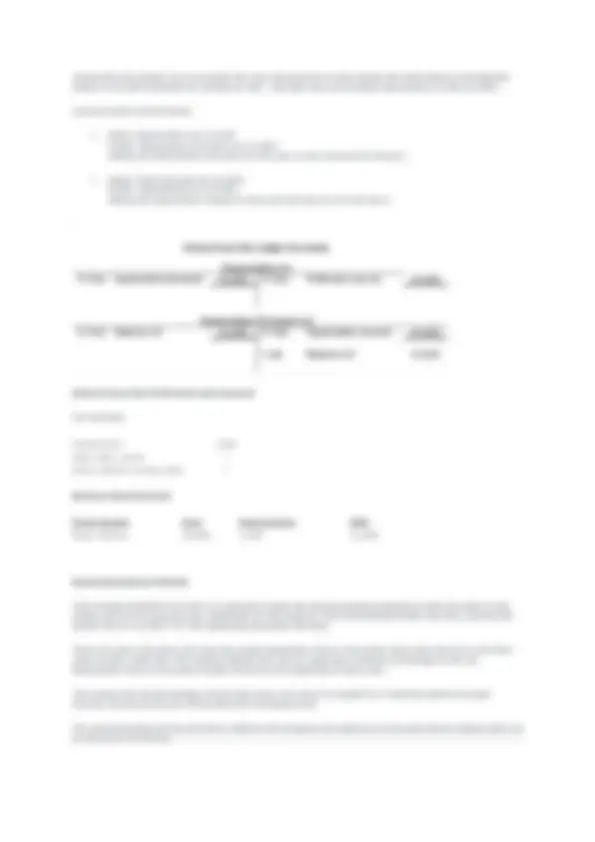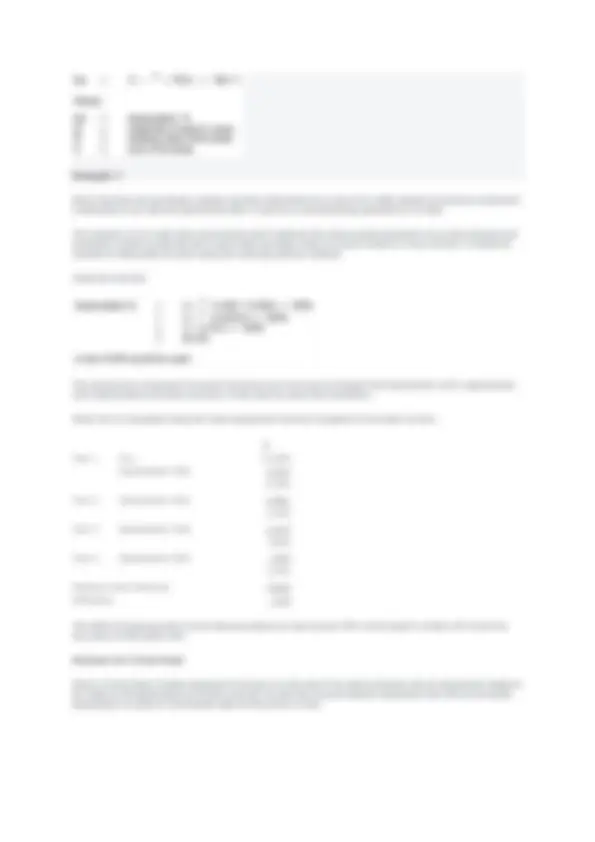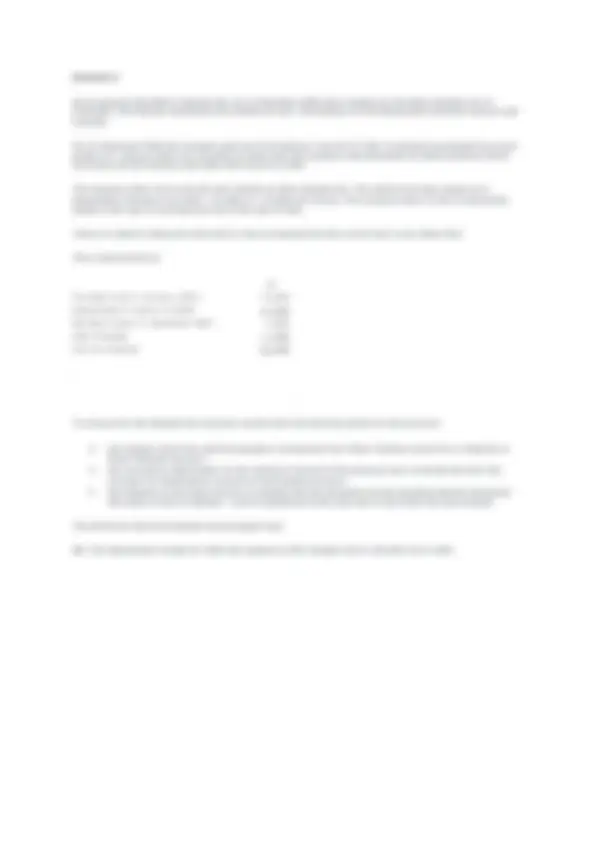





Study with the several resources on Docsity

Earn points by helping other students or get them with a premium plan


Prepare for your exams
Study with the several resources on Docsity

Earn points to download
Earn points by helping other students or get them with a premium plan
Community
Ask the community for help and clear up your study doubts
Discover the best universities in your country according to Docsity users
Free resources
Download our free guides on studying techniques, anxiety management strategies, and thesis advice from Docsity tutors
An in-depth explanation of Depreciation, an essential concept for students studying Manual and Computerised Book-Keeping Level 3. The article covers the definition, purpose, and calculation methods of Depreciation, as well as the impact on profit and loss accounts and balance sheets. Students will also learn about the rules and regulations regarding Depreciation under FRS 15 and the Companies Act.
What you will learn
Typology: Exams
1 / 6

This page cannot be seen from the preview
Don't miss anything!




This months students' newsletter focuses on the concept of Depreciation a knowledge of which is essential to those studying Manual Book-Keeping Level 3 and the Level 3 Computerised test of competence. The early part of the article explains in detail the nature and purpose of Depreciation as a book-keeping and accounting concept. There is mention also of the way in which its definition is embedded in the Accounting Standard FRS 15 (however students of ICB are not examined on a knowledge of such standards) but an awareness of this is most useful in order to understand fully why we create such provisions. I hope that you all find this interesting to read. If any of you have other topics you wish me to cover please contact me at the Institute. Dr Philip E Dunn. Editor One of the most fundamental distinctions made by accountants is between ‘revenue’ and ‘capital’ expenditure. This distinction derives from that by convention, financial statements are produced on an annual basis. Capital expenditure is incurred on the acquisition of fixed assets required for use in the business or that expenditure on existing fixed assets which increase their earning capacity. Revenue expenditure is that incurred on items consumed in the course of ‘doing’ business. It includes amounts paid for raw materials, the cost of power, light and other bought out goods and services. Revenue expenditure is subject to adjustments and is ultimately charged to the profit and loss account when it is deducted from sales income in arriving at profit. Capital expenditure on the other hand is not treated as a direct charge against profit but is held on the balance sheet under the heading of ‘Fixed Assets’, as either tangibles or intangibles. Such assets do not last forever and must eventually be replaced. Any realistic estimation of profits must include a charge for the use of fixed assets, effectively spreading their cost over their revenue producing lives. This charge for ‘use’ is termed Depreciation. It is a notional charge calculated on the basis of a realistic assessment of the life of the assets concerned. Debited to the profit and loss account it is credited to a depreciation provision account where it is held as a balance item – an accumulating deduction from the balance sheet value of the assets concerned. There are rules both in the standard FRS 15, Tangible Fixed Assets, and the Companies Act requirement, which applies to the accounts of companies of all sizes is that the cost (less any residual value) of all assets with a limited useful economic life, "shall be reduced by provisions for depreciation calculated to write off that amount systematically over the period of the assets’ useful economic life".
expected usage of the asset expected physical deterioration of the asset economic or technological obsolescence legal or similar limits on the use of the asset
the cost or revalued amount of the asset; the estimated economic life; and the estimated residual value of the asset.
Straight Line Method Straight line depreciation is calculated by dividing the amount to be written off (cost less estimated residual value) by the asset’s predicted number of years of useful economic life. The figure derived from this calculation then becomes a fixed charge written off each year. As an equal amount is charged each year, a graph plotting the upward accumulation of depreciation year by year would appear as a straight line. Example 1 Sandsend Ltd purchase a new commercial vehicle for £20,000 plus VAT, paid in cash. It is estimated to have an economic life of five years with a residual value after the five years of £3,000. Using the straight line method, the annual charge for depreciation would be: £20,000 - £3,000 = £17,000 / 5 = £3,400 per annum The profits would bear an annual charge of £3,400, while the balance sheet value of the vehicle would be reduced by the same amount each year. The book-keeping entries to deal with the purchase of the asset would be: Debit the motor vehicles (Fixed Asset) account with £20,000. Debit the VAT (input tax) account £3,500. Credit the Cash Book £23,500 cash / cheque payment. At the year end the ‘Depreciation’ account is debited with £3,400, in respect of the vehicle and the ‘Depreciation provision’ is credited with the same amount.
Blyth Chemical Ltd purchase a special machine attachment at a cost of £12,000. Based on previous experience it estimates it can sell the attachment after 4 years to a reconditioning specialist for £1,000. The company is in a high tech environment and it believes the most prudent approach is to write off plant and machinery mostly during the early years after purchase when an income stream is more certain. It therefore chooses to depreciate its plant using the reducing balance method. Using the formula: The double entry treatment is exactly the same as in the case of straight line depreciation with a depreciation and a depreciation provision account, in this case for plant and machinery. When the % calculated using the reducing balance formula is applied to the asset we find: £ Year 1 Cos t 12, Depreciation 46% 5, 6, Year 2 Depreciation 46% 2, 3, Year 3 Depreciation 46% 1, 1, Year 4 Depreciation 46% 869 1, Residual Value Estimate 1, Difference £ The effect of applying 46% to the reducing balance is that around 70% of the asset is written off in the first two years of the asset’s life. Disposal of a Fixed Asset When a Fixed Asset is either disposed of during or at the end of its useful economic life an adjustment needs to be made to the depreciation provision account; so that the account balance represents only the accumulated depreciation to date on fixed assets held at that point in time.
Example 3 Let us assume that Blyth Chemical Ltd, at 31 December 2005 had a balance on its Motor Vehicles a/c of £100,000. This balance represents the vehicles at cost. The balance on the depreciation provision account was £40,000. On 31 December 2006 the company sold one of its delivery vans for £1,500. It had been purchased five years earlier on 1 January 2001, for £15,000, at which time the company had estimated its useful economic life at five years and its residual value after that time of £1,000. The company policy is to write off such vehicles at 20% straight line. The vehicle had been subject to a depreciation charge of (£15,000 - £1,000)/5 = £2,800 per annum. The company policy is also to depreciate assets in the year of purchase but not in the year of sale. There is a need to determine the profit or loss on disposal and the current year must reflect that. This is determined as: £ Purchase Cost (1 January 2001) 15, Depreciation 4 years x £2,800 11, Net Book Value 31 December 2005 3, Sale Proceeds 1, Loss on Disposal £2, To account for this disposal the company would make the following entries to the accounts: the original cost of the vehicle disposed is transferred from Motor Vehicles account to a ‘Disposal of Motor Vehicles Account’; the cumulative depreciation on the vehicle to the end of the previous year is transferred from the Provision for Depreciation account to the Disposal account; the Disposal of the Asset account is credited with the proceeds and the resulting balance represents the profit or loss on disposal – and is transferred at the year end to the Profit and Loss account. The entries for the full procedure would appear thus. NB: The depreciation charge for 2000 was agreed as 20% straight line on £85,000 ie £17,000.